Ticks are a type of parasitic arachnid that can be found across the globe, and you may have heard about them due to their importance in the medical world – as they can be the perfect vector for some diseases. However, they also form part of our ecosystems, acting as a food source for some species. Changes in their distribution or seasonal activity could also be used to indicate changes in our climate.
Read on for this week’s guest blog from the Tick Surveillance Scheme, a project that is helping to monitor tick populations and distributions in the UK.
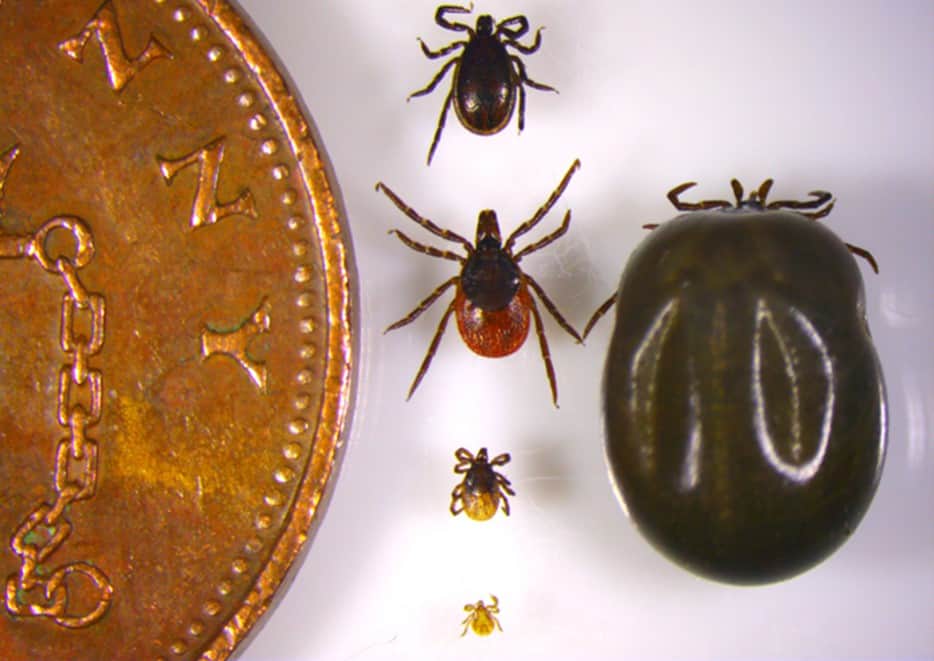
These parasitic arachnids are suggested to have been around for 100 million years, evolving to survive in a wide range of environments across the globe. With up to 1000 known species detected, it is important for us to understand which ones might pose a potential risk to public health. At the UK Health Security Agency, we monitor tick distribution, seasonality, and host associations across the country through our Tick Surveillance Scheme. This allows us to assess distribution or activity changes in our UK species and detect non-native species that might be entering the UK from overseas. Each person interacting with us through the Scheme helps develop our understanding of potential tick-borne disease risk in the UK.
What are ticks and where are they found?
There are 20 species of ticks in the UK and our most common, Ixodes ricinus, or the sheep/deer tick, spends most of its life outside in low-level vegetation. Here, they periodically ‘quest’ on grass, leaves or stems, waiting for an animal host (inc. human) to brush past. Ticks do this because they need to feed on the blood of animals to survive, taking a blood meal to enable the transition from one life stage to the next (larvae to nymph, nymph to adult) or to produce up to 2000 eggs in the case of adult females.
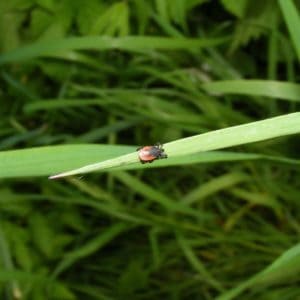
This relatively passive technique of looking for food is not always successful but is the best they can do with a limited amount of fat reserves. As well as trying to preserve energy, every second spent away from the humid mat layer means losing moisture. To rehydrate, ticks will move down to the mat layer, before heading back up the vegetation to create another opportunity for a chance encounter with a host for feeding on. Because of these microclimate restrictions, Ixodes ricinus is only found in certain habitat types (woodland can be very suitable) and they follow a seasonal pattern of activity e.g., less activity in the very hot summer months or during very cold winters. Even in locations with a suitable microclimate, a tick’s life cycle cannot be maintained without suitable hosts to feed on. Microclimatic and animal host factors therefore influence tick survival, and all can be impacted by habitat modification or changes in our climate.
Tick Identification
In the UK, we have a variety of soft ticks (Argasidae) and hard ticks (Ixodidae) – distinguishable by certain morphological features. One species, Dermacentor reticulatus, is particularly easy to differentiate from our most common species (shown above), because they exhibit ornate patterns. If you are trying to identify a tick, one of the first things you can do is work out which family it belongs to, Argasidae or Ixodidae.
Hard ticks have a hardened plate (scutum) that is visible dorsally – see the image above for the dark brown circular patch on the back of the questing female. Hard ticks remain attached to a host and feed for longer periods, increasing in size as the alloscutum (the red part on the female in the image above) expands and fills with blood. Soft ticks do not possess a scutum and take smaller blood meals, usually when their host is in the roost e.g. bats or pigeons.
Another way to tell if you have a hard tick is by viewing the specimen from above, as the capitulum (‘head’ and mouthparts) can be seen extending from the scutum. This is the opposite for soft ticks, as their capitulum is hidden from view and found on their ventral side.
To identify ticks to species level, many will require the use of microscopes and identification keys. As part of our scheme, you can send us your tick specimens, and they will be identified and added to our database.
The Medical Importance of Ticks
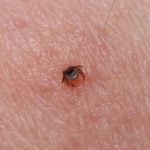
Some tick species can be very host-specific, but others will feed on any animal, and sometimes this includes people. Species, like Ixodes ricinus, that feed on a broad range of hosts are more likely to be infected with pathogens, and more likely to feed on people – this makes them target ‘vector’ species from a public health perspective.
One of the most important tick-borne diseases in the UK is Lyme disease. It is caused by some species of Borrelia bacteria, which Ixodes ricinus can acquire when feeding on wildlife hosts such as small mammals or birds. If a tick gets infected as a larva, then becomes a nymph and bites a human, this can lead to the transmission of the bacteria, which can then cause the disease.
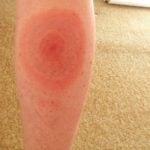
In the UK, there are approximately 1500 cases of Lyme disease confirmed by laboratory testing annually. Many additional cases are thought to occur, however, and these are treated without the need for a blood test – usually, because a patient has presented with a typical erythema migrans (EM) rash and has been given antibiotics to treat the infection. Although treatable with antibiotics, the risk of acquiring Lyme disease can also be reduced by checking regularly for ticks and removing any feeding ticks promptly and safely.
The Tick Surveillance Scheme
Because of the public health impact of ticks in the UK, the Tick Surveillance Scheme was set up to encourage the recording of ticks. The Scheme receives ticks from members of the public, animal or public health specialists, as well as other ecologists, entomologists or biologists that may come across ticks. We record the location and date the tick was found, and the host the tick was removed from. Since the Scheme started in 2005, we have recorded 39 different tick species, and over half of these have been imported into the UK on travelling pets or people. We now have over 10,000 records and have interacted with thousands of individuals about their tick encounters. Our data tell us that tick bites peak in May and June but can happen at any time of the year. The data also show that although our most common species found biting humans is Ixodes ricinus, other species such as the hedgehog tick (Ixodes hexagonus), the red sheep tick (Haemaphysalis punctata) and the ornate cow tick (Dermacentor reticulatus) are also becoming more common biters of humans. We also think there has likely been a shift in the distribution of our main species Ixodes ricinus, which is now reported in new 10 km grids across the UK every year.
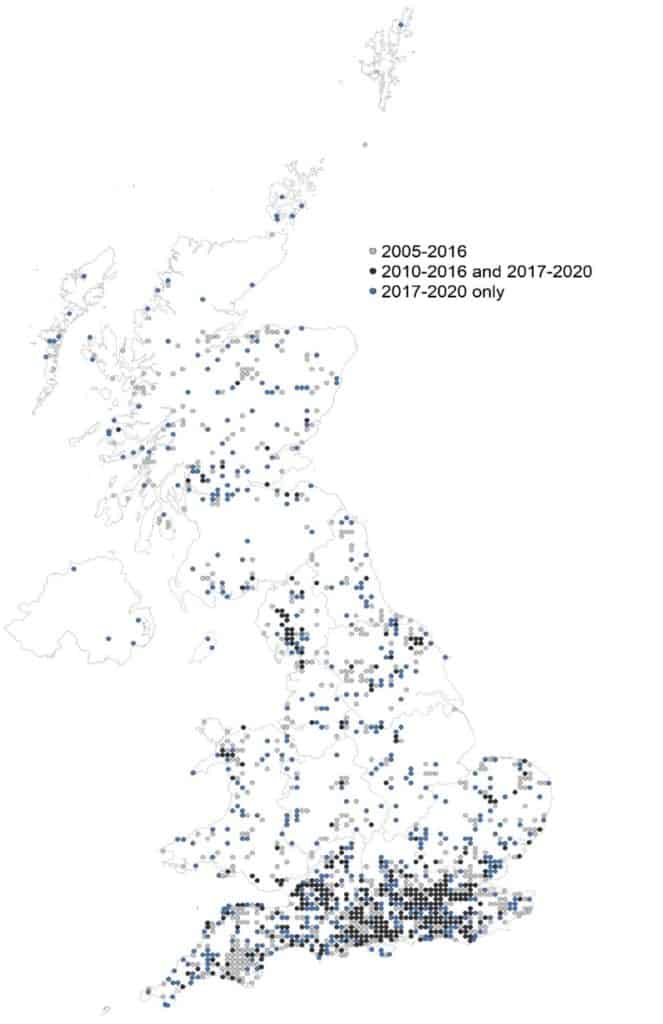
With tick-borne disease risk intrinsically linked to tick distribution and tick distribution likely changing because of anthropogenic modification to our environment, it will be essential to continue collecting data on tick encounters in the UK over the coming decades. If you would like to engage with the Scheme, you can visit our website for more information. We would love to hear about your tick encounters!
If you are responsible for health at a local level and would like to raise awareness of ticks and the potential risks associated with Lyme disease in the UK, we have developed a Tick Awareness Toolkit to support you – you can find more information here.
Further Information and Useful Resources
• The Tick Surveillance Scheme Website
• Bristol University Tick ID Online
• Book to aid identification: Ticks of Europe and North Africa
